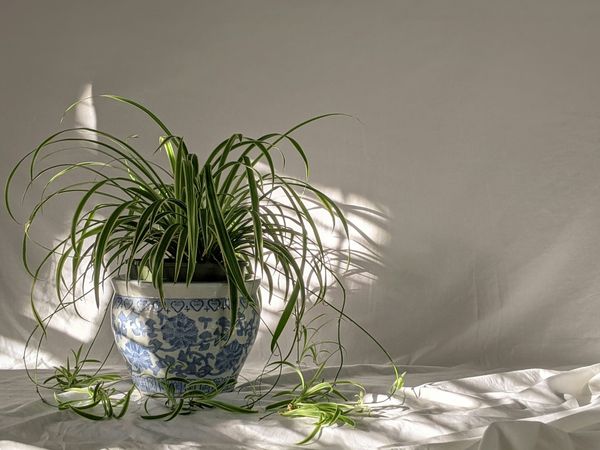Spider Plant Care Guide
How to grow and care for Spider Plant (Chlorophytum comosum)
Chlorophytum comosum, commonly known as the Spider Plant, is one of the most popular houseplants. Loved for its appealing, arching green and white foliage, this plant is easy to care for and adaptable, making it a favorite among indoor gardeners. Spider Plants are also known for their air-purifying abilities, making them not only beautiful but also functional in maintaining a healthy indoor environment.

Disclosure: This content includes affiliate links, which means we may earn a commission if you click on a link and make a purchase. As an Amazon Associate, we earn from qualifying purchases. This comes at no extra cost to you and helps offset the cost of running Leafwise. Please read our disclaimer for more info.
Table of Contents
Care
Light
Spider Plants thrive in a variety of light conditions but perform best in bright, indirect sunlight. While they tolerate lower light, prolonged low light exposure can lead to slower growth and pale leaves. Provide as much indirect light as possible, and avoid placing them in direct sunlight, which can scorch their delicate leaves.
Watering
Water your Spider Plant when the top inch of soil feels dry. They prefer to dry out slightly between waterings, making them drought-tolerant. Overwatering can lead to root rot, so ensure that the pot has adequate drainage. In winter, reduce the watering frequency as the plant's growth slows. For best results, use distilled or rainwater to avoid fluoride damage, which can cause brown leaf tips.
Humidity & Temperature
Maintain indoor temperatures between 65°F and 75°F (18°C to 24°C) and protect the plant from temperatures below 50°F (10°C), as exposure to cold drafts or air-conditioning vents can cause stress. Moderate to high humidity is ideal, but they can tolerate lower humidity levels. Use a pebble tray, humidifier, or mist the leaves occasionally to increase humidity if necessary.
Soil
Use a well-draining potting mix, such as one containing peat moss, perlite, and standard potting soil. This combination ensures proper aeration and prevents water from accumulating around the roots, reducing the risk of rot. A slightly acidic to neutral pH (6.0 to 7.0) is ideal.
Fertilization
Feed your Spider Plant with a balanced liquid fertilizer every 4-6 weeks during the growing season (spring and summer). Avoid over-fertilizing, as it can lead to salt buildup, brown leaf tips, and damage to the plant. Fertilization can be reduced or stopped during the fall and winter months when growth naturally slows.
Maintenance
Cleaning and Trimming
Regularly wipe the leaves with a damp cloth to remove dust and help the plant photosynthesize efficiently. Trim off any brown or damaged leaf tips with clean scissors to maintain the plant's appearance. Brown tips are often caused by fluoride in tap water or low humidity.
Repotting
Repot every 2-3 years or when the plant becomes root-bound. Choose a pot that is 1-2 inches larger and refresh the soil to provide new nutrients. Repotting in spring is ideal to support new growth.
Propagation
Spider Plants are one of the easiest houseplants to propagate thanks to their offshoots (spiderettes):
- Identify a Spiderette: Choose a healthy offshoot with small roots already forming.
- Cut the Spiderette: Use clean, sharp scissors to detach the spiderette from the mother plant.
- Rooting Method:
- Water Method: Place the spiderette in a container of water, ensuring the roots are submerged. Change the water weekly.
- Direct Soil Method: Plant the spiderette directly into moist, well-draining soil.
- Transplanting: Once the roots develop (typically within 2-4 weeks), transfer the new plant into a permanent pot with fresh soil if using the water propagation method.
Common Issues
Pests
Spider Plants are generally resistant to pests but may occasionally attract spider mites, aphids, and whiteflies.
- Prevention: Keep the plant clean and maintain proper humidity levels.
- Solution: Wipe the leaves with soapy water or use a gentle insecticidal soap to eliminate pests. Neem oil can be used for persistent infestations.
Root Rot
Cause: Overwatering or poor drainage.
- Prevention: Ensure the pot has drainage holes and let the soil dry between waterings.
- Solution: If root rot is detected, remove the plant from its pot, trim any rotted roots, and repot in fresh, well-draining soil.
Yellowing Leaves
Cause: Overwatering, poor drainage, or nutrient deficiencies.
- Solution: Reduce watering if the soil is too wet. Ensure the plant is not sitting in water, and apply a balanced fertilizer during the growing season.
Brown Leaf Tips
Cause: Low humidity, over-fertilization, or fluoride in tap water.
- Solution: Increase humidity by misting the plant or using a humidifier. Trim affected tips, reduce fertilization, and consider using distilled or rainwater to prevent fluoride damage.
Pet Safety
Spider Plants are non-toxic to pets, making them a safe choice for homes with cats and dogs. However, cats may be attracted to the plant due to its mild hallucinogenic effect, similar to catnip. While it is not harmful, excessive chewing may damage the plant.
Air Purification
Spider Plants are known for their air-purifying qualities, helping remove toxins such as formaldehyde and xylene from indoor environments. Although the extent of air purification varies, they are a great addition to improving indoor air quality.
By following these care guidelines, your Spider Plant will thrive, producing lush foliage and adorable spiderettes that can easily be propagated to share with friends and family.
